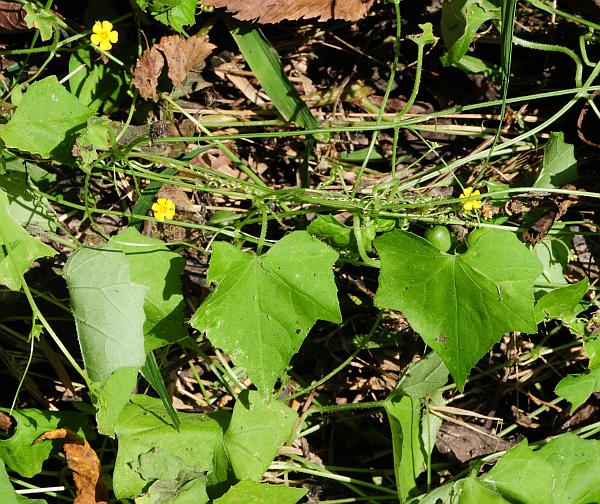Melothria pendula L.
Creeping Cucumber

Native
CC = 8
CW = 0
MOC = 12
© SRTurner
Melothria pendula L.Creeping Cucumber | |
 |
Native CC = 8 CW = 0 MOC = 12 |
© SRTurner |
|
Family - Cucurbitaceae Habit - Monoecious perennial vine with fibrous roots and often a short, woody taproot. Stems - Creeping and sometimes climbing, to 4 m or more, slender, glabrous or sparsely pubescent with short, spreading hairs, not strongly roughened, the tendrils usually unbranched.
Leaves - Alternate, simple, long-petiolate, the petiole 2-3 cm long, with sparse to moderate spreading hairs. Leaf blades 2-6 cm long, 2-9 cm wide, broadly ovate to nearly circular in outline, palmately shallowly to moderately 5-lobed with 3 major lobes and usually 2 minor lobes, the lobes broadly triangular to less commonly oblong-triangular or ovate, with pointed or rounded tips and usually broadly (more than 90°) or rarely narrowly rounded sinuses, cordate at the base, the margins otherwise sparsely toothed, the surfaces sparsely to moderately roughened with inconspicuous, short, pustular-based hairs.
Flowers - Solitary (pistillate) or in small clusters (staminate) in the leaf axils, the main stalk 15-35 mm long, the clustered flowers with individual stalks 1-3 mm long. Calyx lobes 0.2-0.4 mm long. Corollas 3-5 mm wide, saucer-shaped to broadly bell-shaped, the usually 5 lobes 2-3 mm long, yellow to occasionally yellowish green. Staminate flowers with the stamens distinct. Pistillate flowers sometimes with 3 staminodes, the ovary with 3-6 ovules per placenta, the stigma 3-lobed.
Fruits - Solitary, juicy berries, 0.7-1.2 cm long, ovoid to nearly spherical, the rind relatively thin and leathery, indehiscent, with a stalk 30-50 mm long, the surface mottled with darker and lighter green, sometimes yellowish green, becoming black with age, smooth, glabrous, glossy. Seeds 10-14, 3-5 mm long, 2.0-3.5 mm wide, elliptic-obovate to obovate in outline, flattened, sometimes bluntly pointed at the tip, the surface smooth or finely wrinkled, white to off-white, usually shiny.
Flowering - July - October. Habitat - Forests, ditches, ravines, streambanks, acid seeps, roadsides. Origin - Native to the U.S. Lookalikes - None when flowering. Vegetatively the plant resembles Sicyos angulatus. Other info. - This vining relative of cucumbers and squashes is not common in Missouri, but may be expanding its range. In the past it has been confined to far southern counties in the state, but recent anecdotal accounts (Alan Brant and others) have suggested that it is moving northward, and it was discovered growing in Franklin County in 2018. Its broader range includes the southeastern quadrant of the continental U.S., and Mexico. The plant is recognized by its sprawling habit, numerous coiled tendrils, and tiny yellow flowers. Photographs taken at Holly Ridge Conservation Area, Stoddard County, MO, 9-12-2010, General Watkins Conservation Area, Scott County, MO, 7-30-2015, and near Labadie, Franklin County, MO, 9-1-2019 (SRTurner). |